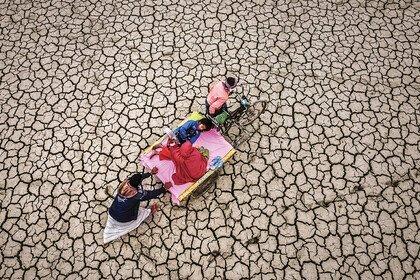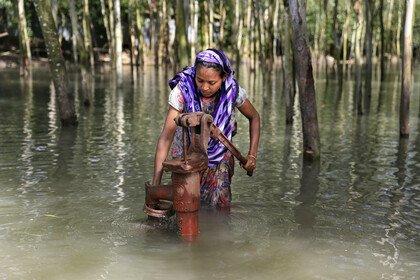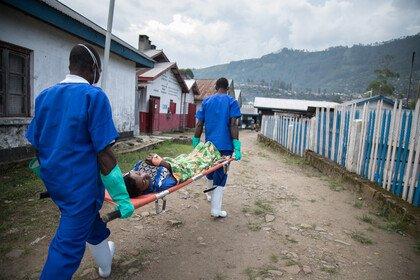
This is how flooding can impact our health
Flooding is devastating in every aspect: from property and infrastructure damage to loss of life and wider health impacts. As flooding becomes increasingly common for more people in a warming world, we look at its repercussions on human health.
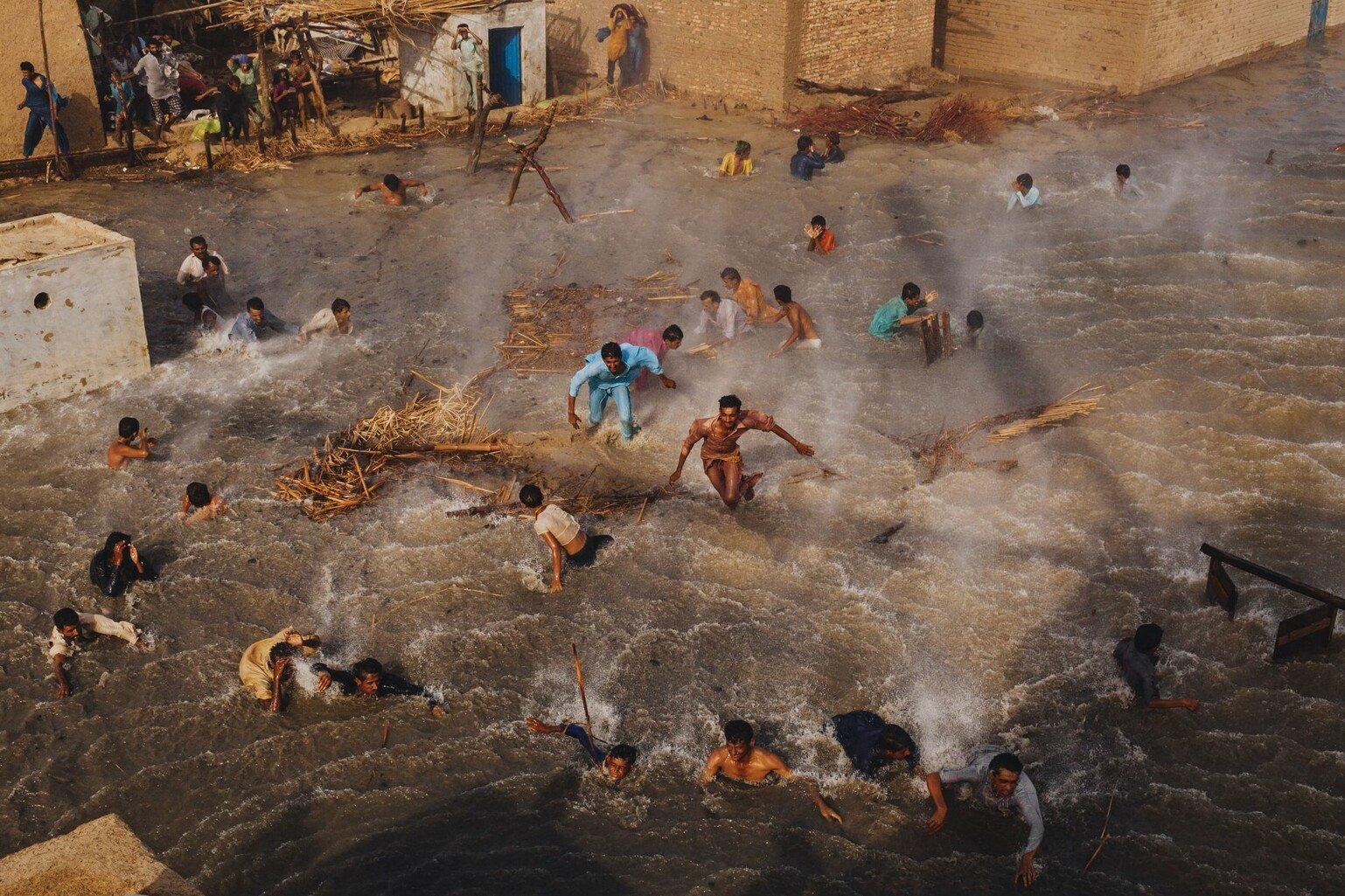
Dadu district, Sindh province, Pakistan
People in a flooded Pakistani village scramble for food rations as they battle the downwash from an army helicopter delivering aid. These unprecedented floods affected approximately 20 million people and destroyed homes, crops and infrastructure, leaving millions vulnerable to malnutrition and waterborne disease such as cholera. Estimates of the total number of people killed range from 1,200 to 2,200, while an estimated 14 million people were left homeless.
The Pakistan floods of 2010 were the result of record monsoon rainfall. As our planet continues to change in ways that are unprecedented in human history, the direct threat to health becomes increasingly urgent. We need to better understand how different populations are affected by climate change so that we can take the necessary actions to protect human health.
Daniel Berehulak, Getty Images / Wellcome Photography Prize 2019
Summary
What are the health effects of floods?
- Climate change makes extreme weather events more common, and more people are likely to experience flooding.
- Diseases, mental health problems and undernutrition or malnutrtion are some of the health effects of flooding.
Flooding is the most common natural disaster globally, affecting more than two billion people worldwide between 1998 and 2017 and with 44% of disasters worldwide associated with it.
As climate change makes the world increasingly susceptible to extreme weather events, more people are likely to experience flooding and its devastation, including its serious impacts on our health.
The Intergovernmental Panel on Climate Change (IPCC) Sixth Assessment Report published in March 2022 highlighted that climate hazards such as flooding are “increasingly contributing to a growing number of adverse health outcomes”.
How can floods affect our health?
Health impacts of flooding
The health impacts of disasters like flooding are complex and cascading, and can impact any one person or population simultaneously.
The kinds of health risks any given community might experience, the severity of them, and just how vulnerable they might be can differ depending on various factors. Geography, population size and density as well as levels of preparedness and resilience are part of it. The flood’s characteristics also play into this, whether it’s flash floods, coastal floods, riverine floods, or permanent floods for low-lying areas.
Floods can directly and indirectly affect human health in both the short and long term. Additionally, it’s not just communities who have experienced flooding whose health is at risk. Disaster responders, healthcare professionals and critical service providers can also be affected.
Drowning is often top of mind when it comes to health risks of flooding. But the risks can range from injuries, hypothermia and animal bites to infectious diseases, undernutrition and mental health problems.
When disasters like floods strike, there is a lot of focus on economic impact and property damage, as well as human casualties. But these also overlap with health concerns in many ways.
Flooding can strain health services due to damaged infrastructure, loss of health professionals and access to medicine, which could delay care or treatment for those who need it.
The economic fallout or loss of possessions and livelihoods due to a flooding disaster can result in financial uncertainty that may affect mental health, to say nothing of the grief from losing loved ones.
Below is an overview of common flooding related health impacts.
Diseases
Diseases and outbreaks are another major health concern in the event of flooding.
These can come in the form of waterborne diseases, which are those that come from drinking or coming into contact with contaminated water. These can include diarrhoea, cholera, typhoid fever and leptospirosis.
It can also sometimes be vector-borne diseases, which come from an intermediate species carrying the disease pathogen like a mosquito. Vector-borne diseases that come about from flooding include dengue fever and malaria.
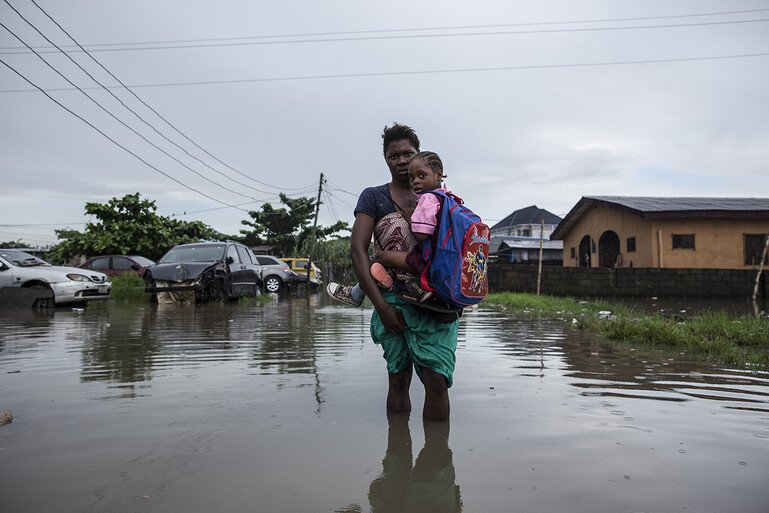
Lagos, Nigeria, 2019.
A mother carries her children to school through a flooded street.
Nyancho NwaNri / Wellcome Photography Prize 2020
Flooding increases the risk of these diseases and potential outbreaks in populations because it can cause sewage overflow as well as damage to water supply and sanitation facilities. Contamination of drinking water can lead to typhoid fever, cholera and hepatitis A.
In areas at risk of coastal flooding, there’s also the possibility of salt-water intrusion to drinking water as well as hypertension and eclampsia.
Once floodwaters have receded, stagnant water left behind in gardens, parts of the home or even farming lands can become a breeding ground for mosquitoes and lead to diseases like dengue or malaria.
Bangladesh had its worst dengue outbreak in 2019, with over 100,000 cases and 179 deaths. The outbreak was attributed to flooding in that year’s monsoon season.
Additionally, displacement and eventual overcrowding in evacuation centres can bring about other issues such as pulmonary and systemic fungal infections from moulds. According to the European Climate and Health Observatory, people that have evacuated to temporary shelters are more likely to be exposed to infectious diseases and pathogens, so are “more prone” to health problems.
Injuries can also potentially lead to infections or diseases such as leptospirosis, a disease that spreads through water contaminated with rodent urine coming into contact with the skin.
In the Philippines – the third most vulnerable country to natural hazards and among the most at risk from climate change – there have been increases in leptospirosis, typhoid fever and dengue after heavy rainfall and flooding.
Mental health problems
Mental health problems, which can occur later, are often overlooked and not as well studied relative to the immediate health impacts caused by flooding. So far, it is known that the experience of surviving a flooding disaster can impact people after the event and sometimes for many years down the line.
Anxiety, depression, post-traumatic stress disorder or PTSD, psychosis and insomnia are some of the common mental health problems that come up in the aftermath of a flooding disaster.
In the UK, flood victims were between 4 to 8.7 times at risk of long-term mental health problems compared to people who did not experience flooding. In one case, rain became a trigger for a woman's PTSD after experiencing flooding in 2000.
The process of clean-up, recovery and rebuilding can be a source of stress, more so if they are not managed well by both government and the private sector.
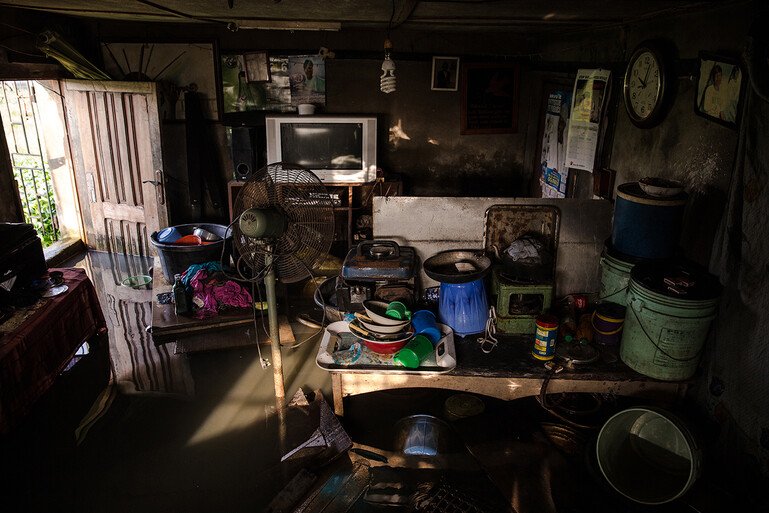
Lagos, Nigeria, 2019
The flooding in this home forced the owners to vacate it, leaving behind their belongings.
Nyancho NwaNri / Wellcome Photography Prize 2020
Disruptions to basic facilities and supplies such as electricity, water and food can likewise be distressing and impact mental health, especially when these are prolonged.
In July 2021, heavy rainfall contributed to some of the worst flooding Western Europe has seen in decades, with over 200 casualties and billions of euros worth of damage. The World Health Organization issued public health advice on the long-term health impacts stemming from disrupted access to essential services and slow recovery. The Center for Disaster Philanthropy then highlighted mental health as a top priority for those affected.
Undernutrition or malnutrition
Though rarely considered, despite evidence for it, undernutrition or malnutrition is another health impact that can result from flooding disasters. Victims have been known to eat less during or after flooding, and often lose access to regular food supplies.
Food systems such as agriculture can also be significantly disrupted because of flooding. This can affect both the quantity and quality of food available and lead to food insecurity and undernutrition.
In parts of South Sudan, flooding due to years of historic rains led to the displacement of hundreds of thousands of people with many resorting to eating wild food such as water lilies owing to the loss of crops and livestock as food sources. Around 7.7 million people were estimated to be at risk of severe food insecurity.
Adapting to the future
Climate change is already exacerbating flooding as warmer temperatures can increase precipitation and cause extreme weather events.
Around 86 million more people have become exposed to flooding from 2000 to 2015. And 1.81 billion people are estimated to already face significant flood risk.
What can we do?
Learning to adapt will be crucial to deal with the health impacts of flooding, alongside mitigation efforts such as reducing emissions.
In Europe alone it’s estimated that without preventive measures up to 2.2 million people will be exposed to coastal flooding by 2100. That number goes down to 1.4 million people with moderate mitigation measures but without adaptation, and as low as 0.6 million if adaptation is factored in.
The health impacts of flooding can only get worse if the world does not take decisive and swift action on climate change.
We’re funding vital research into the impact climate change has on human health around the world, at national, regional and global levels.
There are currently no open funding opportunities for Climate and Health. Learn more about the funding we provide.
